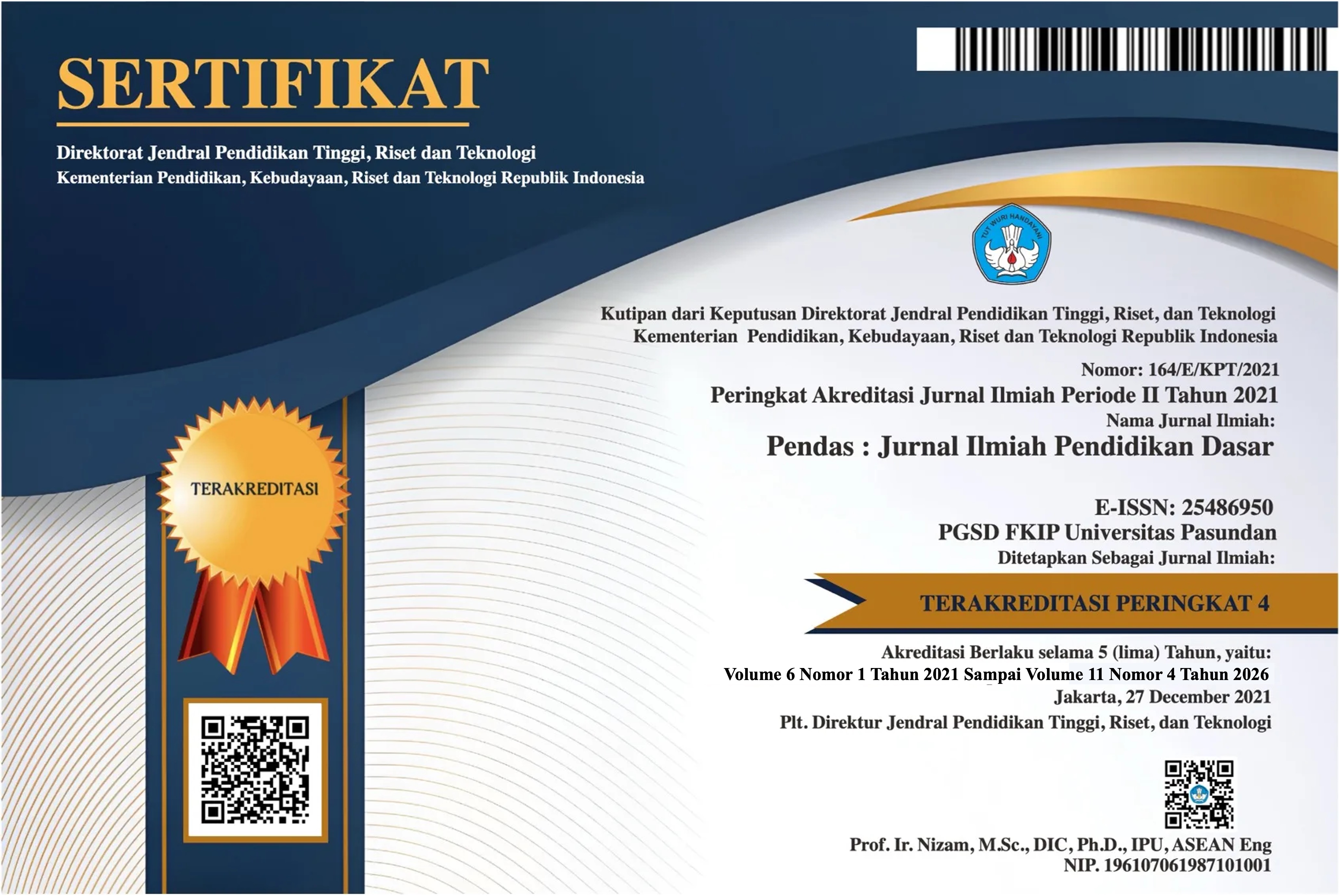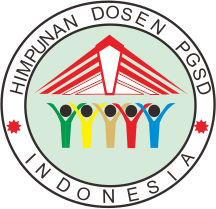DIGITAL SILENCE FOR YOUNG LEARNERS: INTEGRASI KECERDASAN BUATAN DALAM PEMBELAJARAN SILENT WAY UNTUK MENINGKATKAN KOSAKATA BAHASA INGGRIS SISWA SEKOLAH DASAR
DOI:
https://doi.org/10.23969/jp.v10i04.33897Keywords:
English Language LearningAbstract
Vocabulary mastery is a fundamental component of English language learning at the elementary school level. However, vocabulary instruction in schools remains largely teacher-centered, resulting in limited student engagement. The integration of the Silent Way method with Artificial Intelligence (AI) offers the potential to create a more autonomous, interactive, and context-rich learning experience. This study employed a quasi-experimental design with nonequivalent control groups. Students were divided into two groups: the experimental group, which received vocabulary instruction using an AI-assisted Digital Silent Way model, and the control group, which received conventional instruction. The vocabulary test instrument was developed based on established indicators, validated by experts, and tested for reliability prior to use. Data were collected through pre-tests and post-tests, and were analyzed using prerequisite statistical tests and mean difference tests to evaluate the effectiveness of the intervention. The findings indicate no significant difference between the groups at the outset. However, after the intervention, the experimental group demonstrated a marked improvement in vocabulary mastery compared to the control group. The most substantial gains were observed in the ability to use derived words accurately in context. These results suggest that the AI-assisted Digital Silent Way model effectively enhances students’ vocabulary acquisition and promotes active, self-directed learning. This study contributes to the development of innovative English language teaching strategies that align with technological advances and the learning needs of young learners.
Keywords: Silent Way, Artificial Intelligence, Vocabulary Mastery
Downloads
References
Al Hadiq, M. F., & Ramadhan, C. U. (2023). Pengaruh model pembelajaran berbasis investigasi dengan dukungan ChatGPT terhadap keterampilan literasi digital siswa sekolah dasar. COLLASE (Creative of Learning Students Elementary Education), 6(6), 1187–1193. https://doi.org/10.22460/collase.v6i6.21673
Alqahtani, M. (2015). The importance of vocabulary in language learning and how to be taught. International Journal of Teaching and Education, III(3), 21–34. https://doi.org/10.20472/TE.2015.3.3.002
Arifani, Y. (2020). Cartoon video-assisted learning: An investigation into the acquisition of EFL children’s incidental vocabulary. Call-Ej, 21(2), 17–31.
Ashila, L., & Wafa Khilda Dalilah. (2024). Kemampuan Membaca Pada Penerapan Metode The Silent Way Dalam Pengajaran Bahasa Inggris. Karimah Tauhid, 3(5), 5745–5754. https://doi.org/10.30997/karimahtauhid.v3i5.13223
Budiastuti, D. (2022). Validitas dan reliabilitas penelitian.
Creswell, J. W. (2022). Research Design: Qualitative, Quantitative, and Mixed Methods Approaches: by John W. Creswell and J. David Creswell, Los Angeles, CA: SAGE, 2018, $38.34, 304pp., ISBN: 978-1506386706. Taylor & Francis.
Dakhi, S., & Fitria, T. N. (2019). The Principles and the Teaching of English Vocabulary: A Review. JET (Journal of English Teaching), 5(1), 15. https://doi.org/10.33541/jet.v5i1.956
Farrokhnia, M., Banihashem, S. K., Noroozi, O., & Wals, A. (2024). A SWOT analysis of ChatGPT: Implications for educational practice and research. Innovations in Education and Teaching International, 61(3), 460–474. https://doi.org/10.1080/14703297.2023.2195846
Jwair, A. A. Bin. (2023). Improving Middle-School Students’ English Vocabulary Via Digital Storytelling. Journal of Educational and Social Research, 13(6), 195–211. https://doi.org/10.36941/jesr-2023-0158
Kosmas, P., Nisiforou, E. A., Kounnapi, E., Sophocleous, S., & Theophanous, G. (2025). Integrating artificial intelligence in literacy lessons for elementary classrooms: a co-design approach. Educational Technology Research and Development, 0123456789. https://doi.org/10.1007/s11423-025-10492-z
Kurniawati, W. (2020). ASPEK PENGUASAAN KOSAKATA BAHASA INDONESIA OLEH SISWA SEKOLAH DASAR DI KOTA MEDAN Aspect of Mastery Indonesian Vocabulary by Elementary School Students in Medan City Badan Pengembangan dan Pembinaan Bahasa Balai Bahasa Sulawesi Tengah PENDAHULUAN Bahan aj. 9, 386–399.
Li, Y., Zhou, X., Yin, H. B., & Chiu, T. K. F. (2025). Design language learning with artificial intelligence (AI) chatbots based on activity theory from a systematic review. Smart Learning Environments, 12(1). https://doi.org/10.1186/s40561-025-00379-0
Liu, G., & Ma, C. (2024). Measuring EFL learners’ use of ChatGPT in informal digital learning of English based on the technology acceptance model. Innovation in Language Learning and Teaching, 18(2), 125–138. https://doi.org/10.1080/17501229.2023.2240316
Ouyang, F., & Jiao, P. (2021). Artificial intelligence in education: The three paradigms. Computers and Education: Artificial Intelligence, 2(April). https://doi.org/10.1016/j.caeai.2021.100020
Peng, H., Ma, S., & Spector, J. M. (2019). Personalized adaptive learning: an emerging pedagogical approach enabled by a smart learning environment. Smart Learning Environments, 6(1). https://doi.org/10.1186/s40561-019-0089-y
Richards, J. C., & Rodgers, T. S. (Eds.). (2014). The Silent Way. In Approaches and Methods in Language Teaching (3rd ed., pp. 289–302). Cambridge University Press. https://doi.org/DOI: 10.1017/9781009024532.020
Sigit, R., Permana, G., Saroni, M., Junaidi, D., & Hidayah, A. (2023). MindSet : Jurnal Manajemen Pendidikan Islam Penerapan Metode Silent Way Pada Pembelajaran. 2(September).
Sugiyono, P. D. (2019). metode penelitian pendidikan (kuantitatif, kualitatif, kombinasi, R&D dan penelitian pendidikan). Metode Penelitian Pendidikan, 67.
Trilling, B., & Fadel, C. (2009). Bernie Trilling, Charles Fadel-21st Century Skills_ Learning for Life in Our Times -Jossey-Bass (2009). Journal of Sustainable Development Education and Research, 2(1), 243.
Wahyuningsih, S., & Izzah, N. S. (2023). Introducing english vocabulary to young learners through flashcards: evidence from Indonesian elementary school teachers. Jurnal Ilmiah Pendidikan Dasar, 10(2), 88. https://doi.org/10.30659/pendas.10.2.88-99
Zaky, M., Fauziah, A., Zulhannan, &
Downloads
Published
Issue
Section
License
Copyright (c) 2025 Pendas : Jurnal Ilmiah Pendidikan Dasar

This work is licensed under a Creative Commons Attribution 4.0 International License.


















